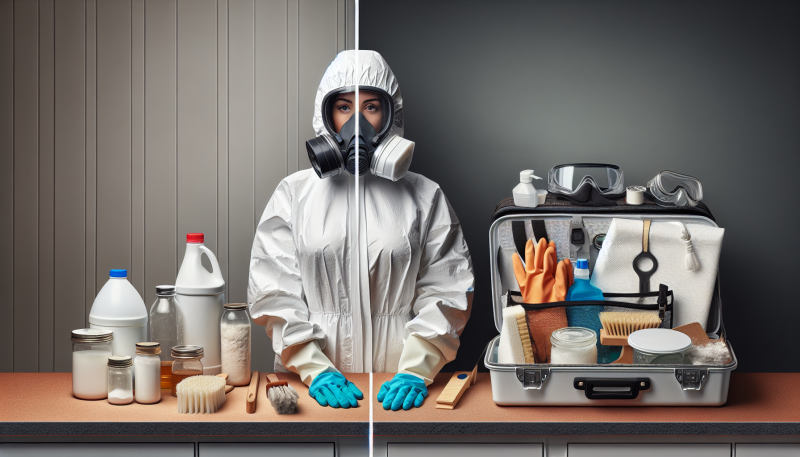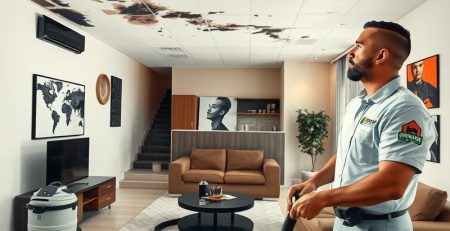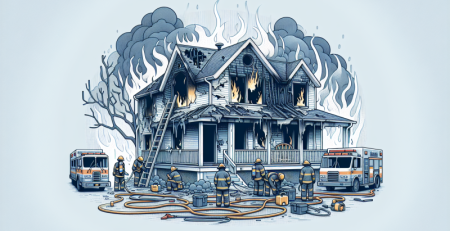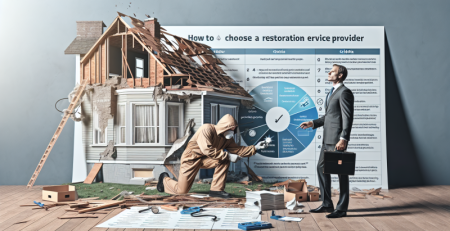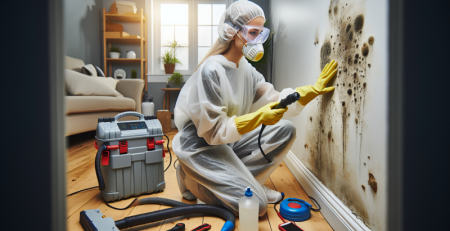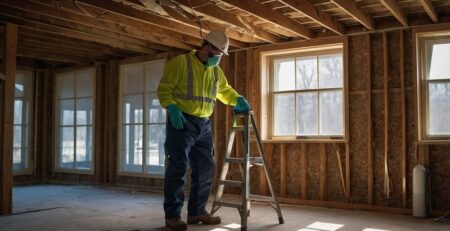Mold Remediation: DIY vs. Professional Help
When it comes to mold remediation, homeowners often find themselves at a crossroads: should they tackle the issue themselves or seek professional help? Mold growth can pose serious health risks and structural damage if not addressed promptly and effectively. In this blog, we’ll explore the pros and cons of DIY mold remediation versus hiring experts like Kraus Restoration, NJ’s leaders in water, mold, and fire damage restoration. With 24/7 emergency services, rapid response times, and IICRC certified experts, Kraus Restoration serves Central and Northern NJ, ensuring your home is safe and mold-free. Call (973) 886-2021 for professional assistance. Understanding the differences between DIY and professional mold remediation can help you make an informed decision that best suits your needs.
Understanding Mold and Its Health Risks
Mold is a common household issue that can lead to significant health risks if not addressed promptly and effectively. Understanding the nature of mold and its potential impact on health is crucial for homeowners, especially when deciding between DIY mold remediation and professional help.
What is Mold?
Mold is a type of fungus that thrives in damp, humid environments. It can grow on various surfaces, including walls, ceilings, and floors, often appearing as black, green, or white spots. Mold reproduces through tiny spores that are released into the air and can easily spread throughout a home.
Health Risks Associated with Mold
Exposure to mold can lead to a range of health problems, particularly for individuals with respiratory conditions, allergies, or weakened immune systems. According to the Centers for Disease Control and Prevention (CDC), common symptoms of mold exposure include:
- Nasal stuffiness
- Throat irritation
- Coughing or wheezing
- Eye irritation
- Skin irritation
In more severe cases, mold exposure can lead to more serious health issues such as:
- Asthma attacks: Mold can trigger asthma symptoms in individuals who are sensitive to it.
- Chronic respiratory conditions: Prolonged exposure to mold can lead to chronic respiratory illnesses.
- Infections: People with weakened immune systems or chronic lung diseases may develop mold infections in their lungs.
Mold Remediation: DIY vs. Professional Help
When it comes to mold remediation, homeowners often face the dilemma of whether to tackle the problem themselves or seek professional assistance. Here are some factors to consider:
DIY Mold Remediation
DIY mold remediation can be a cost-effective solution for small, localized mold issues. Homeowners can use household cleaning products to remove mold from non-porous surfaces. However, DIY remediation has its limitations:
- Limited Effectiveness: DIY methods may not completely eradicate mold, especially if it has penetrated porous materials like drywall or carpet.
- Health Risks: Handling mold without proper protective gear can expose you to harmful spores.
- Lack of Expertise: Identifying the root cause of mold growth and ensuring it doesn’t return can be challenging without professional knowledge.
If you decide to handle the cleanup yourself, having the proper tools for mold removal is non-negotiable.
Professional Mold Remediation
Professional mold remediation services offer a comprehensive approach to mold removal. Experts use specialized equipment and techniques to ensure thorough mold eradication and prevention. Benefits of professional help include:
- Thorough Inspection: Professionals conduct detailed inspections to identify all affected areas and the underlying cause of mold growth.
- Advanced Techniques: They use advanced methods such as HEPA vacuuming, antimicrobial treatments, and air scrubbers to remove mold and prevent recurrence.
- Safety: Professionals follow strict safety protocols to protect themselves and occupants from mold exposure.
Conclusion
Understanding mold and its health risks is essential for making informed decisions about mold remediation. While DIY methods may be suitable for minor mold issues, professional help is often necessary for extensive or recurring mold problems. By choosing professional mold remediation services, homeowners can ensure a safer and healthier living environment.
For more information on mold remediation and other restoration services, visit our mold cleanup page. If you have any questions or need assistance, feel free to contact us.
References
- Centers for Disease Control and Prevention (CDC). “Mold and Health.” Available at: [CDC Mold and Health](https://www.cdc.gov/mold/dampness_facts.htm)
- Environmental Protection Agency (EPA). “Mold Cleanup in Your Home.” Available at: [EPA Mold Cleanup](https://www.epa.gov/mold/mold-cleanup-your-home)
Assessing the Extent of Mold Infestation
When it comes to mold remediation, one of the most critical steps is assessing the extent of mold infestation. Understanding the severity and spread of mold in your home or business is essential for determining whether a DIY approach is feasible or if professional help is necessary. This assessment involves a thorough inspection and evaluation of the affected areas to identify the type and extent of mold growth.
The first step in assessing mold infestation is to conduct a visual inspection. This involves examining areas where mold is commonly found, such as basements, bathrooms, kitchens, and areas with water damage. Look for visible signs of mold, which can appear as black, green, or white spots on walls, ceilings, floors, and other surfaces. Mold often thrives in damp, dark, and humid environments, so pay special attention to areas with poor ventilation and high moisture levels.
In addition to a visual inspection, it’s important to identify any musty odors, which can be a strong indicator of hidden mold growth. Mold can sometimes grow behind walls, under carpets, or in other concealed areas, making it difficult to detect without a thorough inspection. If you notice a persistent musty smell, it may be necessary to investigate further to locate the source of the odor.
Another crucial aspect of assessing mold infestation is identifying the source of moisture that is contributing to mold growth. Mold requires moisture to thrive, so addressing the underlying cause of the moisture problem is essential for effective remediation. Common sources of moisture include leaks in roofs, windows, or pipes, as well as condensation and poor ventilation. Identifying and fixing these issues can help prevent future mold growth and ensure a successful remediation process.
For a more comprehensive assessment, consider using moisture meters and hygrometers to measure the moisture levels in different areas of your home or business. These tools can help identify areas with high humidity or moisture content, which are more susceptible to mold growth. Additionally, infrared cameras can be used to detect hidden moisture behind walls and other surfaces, providing a more accurate picture of the extent of the infestation.
In some cases, it may be necessary to collect air and surface samples to determine the type and concentration of mold present. This can be particularly important if you suspect toxic mold, such as Stachybotrys chartarum, which can pose serious health risks. Professional mold inspectors have the expertise and equipment to collect and analyze these samples, providing valuable information for the remediation process.
Once you have a clear understanding of the extent of the mold infestation, you can make an informed decision about whether to tackle the remediation yourself or seek professional help. For small, localized infestations, a DIY approach may be sufficient, provided you have the necessary knowledge and tools to safely and effectively remove the mold. However, for larger or more severe infestations, professional mold remediation services are often the best option.
Professional mold remediation companies, such as Kraus Restoration, have the expertise, experience, and equipment to handle even the most challenging mold problems. They can conduct a thorough assessment, identify the source of moisture, and develop a comprehensive remediation plan to safely and effectively remove the mold. Additionally, professional services often include measures to prevent future mold growth, such as improving ventilation and addressing moisture issues.
In conclusion, assessing the extent of mold infestation is a critical step in the mold remediation process. A thorough inspection and evaluation can help you determine the severity of the problem and decide whether a DIY approach or professional help is needed. By addressing the underlying moisture issues and taking appropriate remediation measures, you can ensure a safe and healthy environment for your home or business. For more information on mold remediation and other restoration services, visit Kraus Restoration’s mold cleanup page or contact their team of experts.
DIY Mold Remediation: Tools and Techniques
When it comes to mold remediation, many homeowners grapple with the decision of whether to tackle the problem themselves or seek professional help. DIY mold remediation can be a viable option for small, contained areas of mold growth. However, it requires the right tools and techniques to ensure the mold is effectively removed and does not return. Here, we will explore the essential tools and techniques needed for successful DIY mold remediation.
Essential Tools for DIY Mold Remediation
- Protective Gear: Safety should be your top priority when dealing with mold. Equip yourself with protective gear, including gloves, goggles, and a respirator mask. Mold spores can cause respiratory issues and skin irritation, so it’s crucial to minimize exposure.
- HEPA Vacuum: A High-Efficiency Particulate Air (HEPA) vacuum is essential for capturing mold spores and preventing them from spreading. Use the HEPA vacuum to clean surfaces and remove loose mold particles before and after the remediation process.
- Cleaning Solutions: Various cleaning solutions can be effective in killing mold. A mixture of water and detergent can be used for non-porous surfaces, while a solution of water and white vinegar is effective for porous surfaces. For more stubborn mold, consider using a commercial mold remover.
- Scrub Brushes and Sponges: These tools are necessary for scrubbing mold off surfaces. Choose brushes and sponges that are durable and can reach into crevices where mold may be hiding.
- Plastic Sheeting and Tape: To prevent mold spores from spreading to other areas of your home, use plastic sheeting and tape to seal off the affected area. This containment strategy is crucial in maintaining a controlled environment during the remediation process.
- Dehumidifier: Mold thrives in damp environments, so it’s essential to reduce humidity levels in your home. A dehumidifier can help maintain a dry environment, making it less conducive for mold growth.
Techniques for Effective Mold Remediation
- Identify and Assess the Mold Problem: Before you begin, identify the extent of the mold problem. Look for visible signs of mold and use a moisture meter to detect hidden moisture sources. This assessment will help you determine the scope of the remediation needed.
- Contain the Area: As mentioned earlier, use plastic sheeting and tape to seal off the affected area. This containment prevents mold spores from spreading to other parts of your home during the cleaning process.
- Remove and Dispose of Contaminated Materials: For porous materials like drywall, insulation, and carpeting that are heavily infested with mold, it’s best to remove and dispose of them. Place these materials in sealed plastic bags to prevent spores from escaping during disposal.
- Clean and Disinfect Surfaces: Use your chosen cleaning solution to scrub mold off non-porous surfaces. For porous surfaces, apply the solution and allow it to sit for a few minutes before scrubbing. After cleaning, disinfect the area to kill any remaining mold spores.
- Dry the Area Thoroughly: After cleaning, ensure the area is thoroughly dried. Use fans, dehumidifiers, and open windows to promote air circulation and speed up the drying process. Moisture control is key to preventing future mold growth.
- Monitor for Recurrence: Even after successful remediation, it’s important to monitor the area for any signs of mold recurrence. Regularly check for moisture and mold growth, and address any issues promptly to prevent a re-infestation.
While DIY mold remediation can be effective for small-scale problems, it’s important to recognize when professional help is needed. For extensive mold infestations or mold growth caused by water damage, it’s best to consult with a professional mold remediation service. Professionals have the expertise and equipment to handle large-scale mold problems safely and effectively.
For more information on professional mold remediation services, visit our mold cleanup page. If you have any questions or need assistance, feel free to contact us. Additionally, you can learn more about our comprehensive range of services by visiting our services page.
When to Call in the Professionals
Mold remediation is a critical process that ensures the safety and health of your living or working environment. While some minor mold issues can be tackled with DIY methods, there are situations where professional intervention becomes necessary. Knowing when to call in the experts can save you time, money, and potential health risks.
One of the primary indicators that you need professional help is the size of the mold infestation. According to the Environmental Protection Agency (EPA), if the moldy area is less than 10 square feet, you might be able to handle it yourself. However, if the affected area is larger, it’s time to seek professional assistance. Large infestations often indicate underlying issues such as water damage or high humidity levels that need to be addressed to prevent future mold growth.
Another crucial factor is the type of mold present. While most molds are not harmful, certain types, such as black mold (Stachybotrys chartarum), can pose serious health risks. Black mold produces mycotoxins that can cause respiratory issues, skin irritation, and other health problems. If you suspect the presence of toxic mold, it’s essential to contact professionals who have the expertise and equipment to safely remove it.
Visible mold is not the only concern; hidden mold can be equally problematic. Mold can grow behind walls, under floors, and in other concealed areas, often due to water leaks or high humidity. If you notice a musty odor, experience unexplained health issues, or see signs of water damage, it’s wise to have a professional inspection. Experts use advanced tools such as moisture meters and infrared cameras to detect hidden mold and assess the extent of the infestation.
Health concerns are another significant reason to call in professionals. Mold exposure can cause various health issues, especially for individuals with allergies, asthma, or weakened immune systems. Symptoms can range from mild irritation to severe respiratory problems. If you or anyone in your household experiences persistent health issues that seem to worsen in certain areas of your home, it’s crucial to have a professional mold assessment and remediation.
The source of the mold problem also plays a vital role in deciding whether to seek professional help. Mold thrives in damp environments, so identifying and addressing the source of moisture is essential. Professionals can pinpoint the cause, whether it’s a leaky roof, plumbing issues, or poor ventilation, and provide comprehensive solutions to prevent future mold growth.
Attempting to remove mold without proper knowledge and equipment can sometimes exacerbate the problem. Disturbing mold can release spores into the air, spreading the contamination to other areas of your home. Professionals use specialized containment procedures and air filtration systems to prevent cross-contamination and ensure thorough removal.
In addition to health and safety concerns, professional mold remediation offers peace of mind. Certified mold remediation specialists follow industry standards and guidelines to ensure effective and safe mold removal. They provide detailed assessments, remediation plans, and post-remediation verification to confirm that the mold has been successfully eliminated.
If you’re dealing with a mold problem, it’s essential to choose a reputable company with experience in mold remediation. At Kraus Restoration, we offer comprehensive mold cleanup services tailored to your specific needs. Our team of certified professionals uses state-of-the-art equipment and techniques to ensure your home or business is mold-free and safe. For more information about our services, visit our About page or contact us today.
In conclusion, while minor mold issues can sometimes be managed with DIY methods, larger infestations, toxic mold, hidden mold, health concerns, and moisture problems necessitate professional intervention. By recognizing these signs and seeking expert help, you can ensure a safe and healthy environment for you and your loved ones.
Cost Comparison: DIY vs. Professional Mold Remediation
When it comes to mold remediation, homeowners often find themselves at a crossroads: should they tackle the problem themselves or hire a professional? One of the most significant factors influencing this decision is cost. Understanding the financial implications of both DIY and professional mold remediation can help you make an informed choice.
DIY Mold Remediation Costs
Opting for a DIY approach to mold remediation can initially seem like a cost-effective solution. The primary expenses involved are the materials and tools required for the job. Here’s a breakdown of typical costs:
- Protective Gear: Safety is paramount when dealing with mold. You’ll need gloves, goggles, and a high-quality respirator mask. These items can cost between $50 and $150.
- Cleaning Supplies: Effective mold removal requires specialized cleaning agents. A gallon of mold-killing solution can range from $10 to $30. You may also need scrub brushes, sponges, and disposable rags, adding another $20 to $50 to your expenses.
- Tools and Equipment: Depending on the extent of the mold infestation, you might need tools like a dehumidifier, which can cost anywhere from $150 to $300. Additionally, you may need a HEPA vacuum, priced between $200 and $500.
- Testing Kits: To ensure that you’ve completely eradicated the mold, you might want to invest in a mold testing kit, which can cost around $20 to $50.
In total, a DIY mold remediation project can cost anywhere from $250 to $1,000, depending on the severity of the infestation and the quality of the materials and tools you purchase.
Professional Mold Remediation Costs
Hiring a professional mold remediation service involves a different set of costs. While it may seem more expensive upfront, the comprehensive nature of professional services often justifies the investment. Here’s what you can expect:
- Inspection Fees: Most professional mold remediation companies charge an initial inspection fee, which can range from $200 to $600. This fee covers the cost of assessing the extent of the mold problem and developing a remediation plan.
- Remediation Costs: The actual cost of mold remediation varies based on the size and severity of the infestation. On average, professional mold remediation can cost between $500 and $6,000. For extensive mold problems, especially those involving HVAC systems or structural components, costs can escalate to $10,000 or more.
- Post-Remediation Testing: To ensure that the mold has been completely removed, many companies offer post-remediation testing. This service can add an additional $100 to $300 to your total cost.
While professional mold remediation can be more expensive, it often includes a thorough inspection, complete removal, and preventive measures to avoid future infestations. This comprehensive approach can save you money in the long run by preventing recurring mold problems.
Weighing the Costs and Benefits
When comparing the costs of DIY and professional mold remediation, it’s essential to consider the potential risks and benefits of each approach. DIY mold remediation can be cost-effective for minor infestations, but it requires a significant time investment and carries the risk of incomplete removal, which can lead to recurring problems.
On the other hand, professional mold remediation offers a more thorough and reliable solution. Professionals have the expertise, experience, and equipment to handle even the most severe mold infestations. They can also identify and address the underlying causes of mold growth, such as water leaks or poor ventilation, providing a long-term solution.
If you’re dealing with a minor mold problem and feel confident in your ability to handle it, a DIY approach might be suitable. However, for more extensive infestations or if you’re unsure about the severity of the problem, hiring a professional is likely the best option. For more information on professional mold remediation services, visit our mold cleanup page. If you have any questions or need further assistance, don’t hesitate to contact us.
In conclusion, while the initial cost of professional mold remediation may be higher, the long-term benefits and peace of mind it offers can make it a worthwhile investment. Whether you choose a DIY approach or opt for professional help, addressing mold problems promptly and effectively is crucial for maintaining a healthy and safe living environment.
Long-term Prevention Strategies
When it comes to mold remediation, whether you choose to tackle the issue yourself or hire professionals, implementing long-term prevention strategies is crucial to ensure that mold does not return. Mold can cause significant health problems and structural damage if not properly managed. Therefore, understanding and applying effective prevention techniques can save you time, money, and stress in the long run.
One of the most effective long-term prevention strategies is controlling moisture levels in your home. Mold thrives in damp environments, so it’s essential to keep humidity levels below 60%. Using dehumidifiers in areas prone to moisture, such as basements and bathrooms, can help maintain optimal humidity levels. Additionally, ensure that your home is well-ventilated. Proper ventilation in kitchens, bathrooms, and laundry rooms can significantly reduce the risk of mold growth. Installing exhaust fans and ensuring that they are vented to the outside can help remove excess moisture from these areas.
Regular maintenance and inspections are also vital in preventing mold. Check your home for leaks in the roof, walls, and plumbing systems. Even small leaks can create a conducive environment for mold growth if left unattended. Repair any leaks promptly and consider using mold-resistant products when making repairs or renovations. For instance, mold-resistant drywall and paint can provide an extra layer of protection against mold.
Another critical aspect of long-term mold prevention is proper cleaning and upkeep. Regularly clean areas that are prone to mold, such as bathrooms and kitchens, with mold-killing products. Pay special attention to areas around sinks, tubs, and showers. It’s also important to clean and dry any spills or water damage immediately. Mold can begin to grow within 24-48 hours of water exposure, so prompt action is essential.
In addition to these measures, consider investing in professional mold inspections and maintenance services. Professionals can identify potential problem areas that you might overlook and provide tailored solutions to prevent mold growth. They can also offer advice on the best practices for maintaining a mold-free environment. For more information on professional services, you can visit our mold cleanup page.
Landscaping and exterior maintenance also play a role in mold prevention. Ensure that the ground around your home slopes away from the foundation to prevent water from pooling near the structure. Clean gutters and downspouts regularly to ensure they are directing water away from your home. Additionally, consider installing a sump pump in your basement to manage groundwater and prevent flooding.
If you have experienced significant mold issues in the past, it might be worth considering more extensive measures, such as waterproofing your basement or crawl space. These areas are particularly susceptible to moisture and mold growth. Waterproofing can involve sealing walls and floors, installing drainage systems, and using vapor barriers to keep moisture out.
Educating yourself and your household about the signs of mold and the importance of moisture control can also contribute to long-term prevention. Understanding the early signs of mold, such as musty odors, discoloration on walls or ceilings, and respiratory issues, can help you address problems before they escalate. Encourage everyone in your home to report any signs of mold or moisture problems immediately.
In conclusion, long-term mold prevention requires a combination of moisture control, regular maintenance, proper cleaning, and professional assistance. By implementing these strategies, you can significantly reduce the risk of mold growth and maintain a healthy living environment. For more detailed information on mold remediation and prevention, feel free to explore our services or contact us for personalized advice and solutions.
Case Studies: Success Stories and Lessons Learned
When it comes to mold remediation, the choice between DIY methods and professional help can significantly impact the outcome. To illustrate the differences, let’s delve into some real-world case studies that highlight both success stories and lessons learned.
Case Study 1: The DIY Attempt
John, a homeowner in a humid region, noticed mold growth in his basement. Believing he could handle it himself, he purchased a mold removal kit from a local hardware store. Armed with bleach and a scrub brush, John set to work. Initially, it seemed like he had successfully removed the mold. However, within a few weeks, the mold returned, this time more aggressively.
Lessons Learned:
- Incomplete Removal: John’s DIY approach failed to address the root cause of the mold growth. Professional mold remediation services, like those offered by Kraus Restoration, include thorough inspections to identify and eliminate the source of moisture that fosters mold growth.
- Health Risks: John experienced respiratory issues due to improper handling of mold. Professionals use specialized equipment and protective gear to ensure safety during the remediation process.
- Long-term Costs: The initial savings from a DIY approach were overshadowed by the recurring mold problem, which eventually required professional intervention. This case underscores the importance of investing in professional help to avoid long-term expenses.
Case Study 2: Professional Intervention
Sarah, a small business owner, discovered mold in her office building. Understanding the potential health risks to her employees and clients, she immediately contacted a professional mold remediation company. The experts conducted a comprehensive assessment and implemented a multi-step remediation process, including containment, removal, and preventive measures.
Success Story:
- Thorough Assessment: The professionals identified hidden mold in areas Sarah hadn’t considered, such as behind walls and under carpets. This comprehensive approach ensured complete removal.
- Advanced Techniques: Using state-of-the-art equipment, the team effectively contained and removed the mold, preventing cross-contamination to other areas of the building.
- Preventive Measures: The professionals provided Sarah with valuable advice on maintaining a mold-free environment, such as improving ventilation and controlling humidity levels. This proactive approach has kept her office mold-free for years.
Case Study 3: Residential Transformation
The Smith family faced a severe mold problem in their newly purchased home. Concerned about their children’s health, they opted for professional help. The remediation team from Kraus Restoration not only removed the mold but also restored the affected areas, transforming their home into a safe and healthy living space.
Success Story:
- Comprehensive Service: The team handled everything from mold removal to restoration, ensuring the home was safe and aesthetically pleasing. This all-in-one service saved the Smiths time and stress.
- Health Benefits: The family noticed immediate improvements in their health, particularly in their children’s respiratory conditions. This case highlights the importance of professional mold remediation in safeguarding health.
- Increased Property Value: The thorough remediation and restoration work increased the home’s market value, proving that professional intervention can be a worthwhile investment.
Conclusion
These case studies clearly demonstrate the advantages of opting for professional mold remediation over DIY methods. While DIY attempts may seem cost-effective initially, they often fail to address the root cause and can lead to recurring problems and health risks. On the other hand, professional services offer comprehensive solutions, advanced techniques, and preventive measures that ensure long-term success.
For those facing mold issues, it’s crucial to consider the benefits of professional help. Companies like Kraus Restoration provide expert services that not only remove mold but also restore and protect your property. Whether it’s a residential or commercial space, investing in professional mold remediation is a step towards a healthier and safer environment. If you need assistance, don’t hesitate to contact the experts for a consultation.
In conclusion, tackling mold remediation requires a careful assessment of the situation to determine whether a DIY approach or professional help is the best course of action. While DIY methods can be cost-effective and suitable for small, manageable mold issues, they come with risks such as incomplete removal and potential health hazards. On the other hand, professional mold remediation services offer thorough and safe solutions, especially for extensive or toxic mold infestations, but they can be more expensive.
Ultimately, the choice between DIY and professional help depends on the severity of the mold problem, your budget, and your comfort level with handling potentially hazardous materials. Prioritize your health and safety by making an informed decision, and don’t hesitate to consult with professionals if you have any doubts. By addressing mold issues promptly and effectively, you can ensure a healthier living environment for you and your loved ones.
